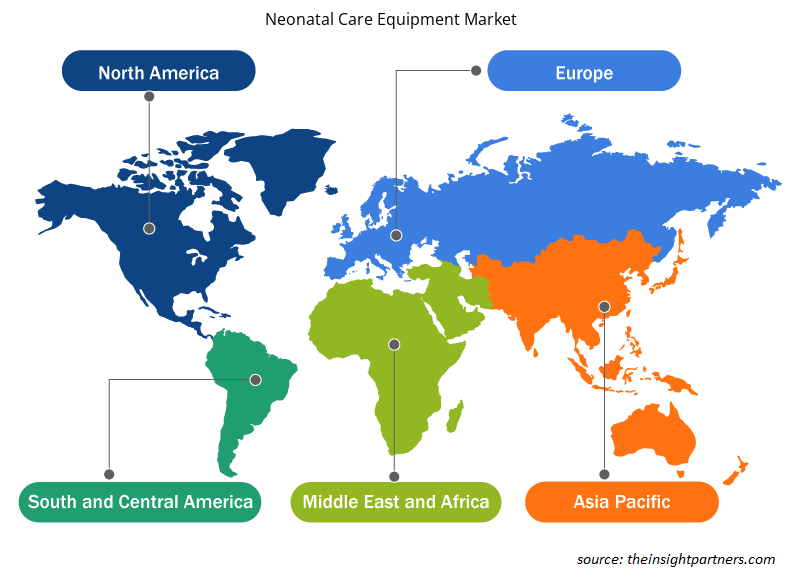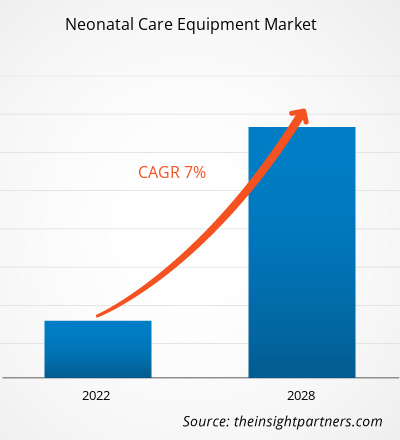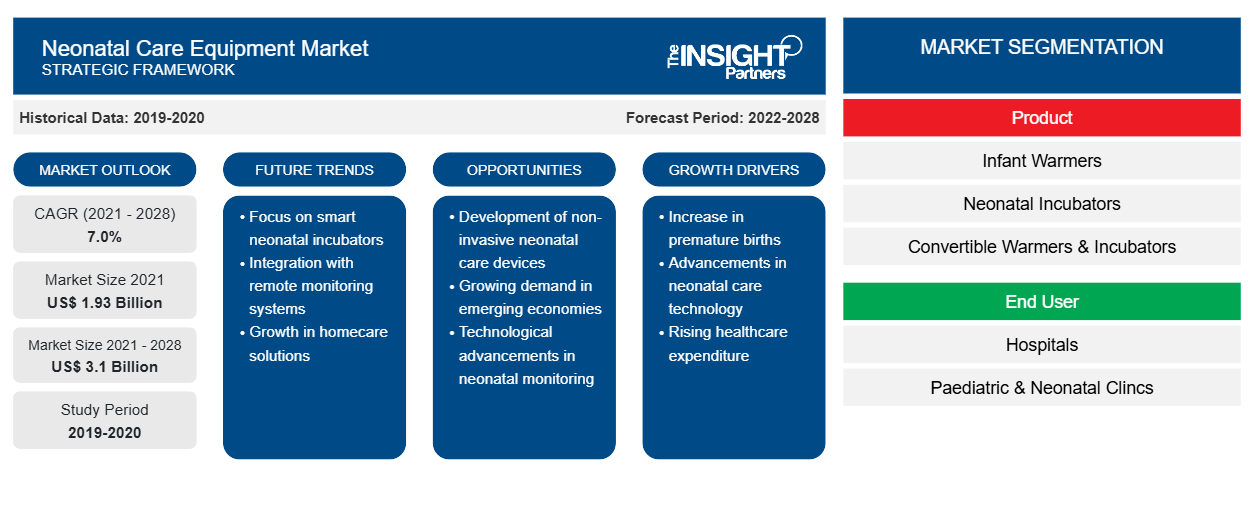Der Markt für Neugeborenenpflegegeräte soll von 1.934,24 Millionen US-Dollar im Jahr 2021 auf 3.103,81 Millionen US-Dollar im Jahr 2028 anwachsen. Von 2022 bis 2028 wird eine durchschnittliche jährliche Wachstumsrate (CAGR) von 7,0 % erwartet.CAGR of 7.0% from 2022 to 2028.
Geräte für die Neugeborenenpflege werden verwendet, um kleine und kranke Neugeborene warm zu halten, ihr Wachstum zu überwachen, Gelbsucht zu behandeln und Sauerstoff oder Atemunterstützung bereitzustellen. Die Säuglinge werden mit verschiedenen Geräten wie elektrischen Wärmern, Neugeborenenbeatmungsgeräten, Geräten zur kontinuierlichen positiven Atemwegsüberdrucktherapie, Blutdruckmessgeräten, Herzmonitoren, Pulsoximetern, Kapnographen, integrierten Überwachungsgeräten und anderen Geräten versorgt.
Der Bericht bietet Einblicke und eine eingehende Analyse des globalen Marktes für Neugeborenenpflegegeräte und hebt dabei verschiedene Parameter wie Markttrends, technologische Fortschritte und Marktdynamik hervor. Darüber hinaus bietet er eine Analyse der Wettbewerbslandschaft führender Marktteilnehmer und die Auswirkungen der COVID-19-Pandemie auf den Markt in allen wichtigen Regionen.
Passen Sie diesen Bericht Ihren Anforderungen an
Sie erhalten kostenlos individuelle Anpassungen an jedem Bericht, einschließlich Teilen dieses Berichts oder einer Analyse auf Länderebene, eines Excel-Datenpakets sowie tolle Angebote und Rabatte für Start-ups und Universitäten.
-
Holen Sie sich die wichtigsten Markttrends aus diesem Bericht.Dieses KOSTENLOSE Beispiel umfasst eine Datenanalyse von Markttrends bis hin zu Schätzungen und Prognosen.
Die Kosten für die Gesundheitsversorgung steigen in Nordamerika stark an. Das US-Gesundheitssystem verursachte im Jahr 2020 direkte Kosten in Höhe von 5,3 Milliarden US-Dollar. Das Gesundheitssystem trug 2020 zusätzlich zu den jährlichen Gesamtkosten des Landes 60 Milliarden US-Dollar bei. Über 40 % der Bevölkerung Nordamerikas sagten 2020 ihre Termine ab, und 13 % gaben an, dass sie Behandlung benötigten, aber keine vereinbarten oder erhielten. Die COVID-19-Pandemie veränderte die wirtschaftlichen Bedingungen und das Sozialverhalten in den nordamerikanischen Ländern. Die von den Regierungen erlassenen Eindämmungsmaßnahmen zur Eindämmung der Krankheitsausbreitung veränderten das Versorgungsmuster des US-Gesundheitswesens. Nach Angaben der Abteilung für Notfallmedizin gingen die Besuche in der Notaufnahme in vielen Städten des Landes im Jahr 2020 um etwa 40 % zurück. Darüber hinaus wurden ambulante Termine und Wahlbehandlungen verschoben oder durch Telemedizin ersetzt.
Im November 2021 kündigte Pfizer Inc. den in der Erprobung befindlichen oralen antiviralen COVID-19-Kandidaten PAXLOVID an. Basierend auf einer Zwischenanalyse der Phase 2/3-Evaluation der Proteasehemmung für COVID-19 bei Hochrisikopatienten (EPIC-HR), einer randomisierten, doppelblinden Studie an nicht hospitalisierten erwachsenen COVID-19-Patienten, die ein hohes Risiko für einen schweren Krankheitsverlauf hatten, reduzierte der PAXLOVID-Impfstoff Berichten zufolge die Zahl der Krankenhausaufenthalte und Todesfälle. In den ersten Monaten des Jahres 2021 kam es zu Lieferengpässen im Zusammenhang mit der Impfstoffproduktion. Der Aufbau neuer Anlagen und die Förderung technologischer Veränderungen sind jedoch die Strategien, die die Produktion von Auffrischungsdosen in den USA und Kanada sowie deren Verabreichungspläne unterstützen.investigational COVID-19 oral antiviral candidate, PAXLOVID. Based on an interim analysis of the Phase 2/3 Evaluation of Protease Inhibition for COVID-19 in High-Risk Patients (EPIC-HR), a randomized, double-blind study of non-hospitalized adult COVID-19 patients who were at a high risk of progressing to severe illness, the PAXLOVID vaccine reportedly reduced hospitalization and death. There were supply constraints related to vaccine production in the initial months of 2021. However, setting up new plants and promoting technological shifts are the strategies that support the production of booster doses in the US and Canada, along with their administration plans.
Frühgeborene und termingerecht geborene Säuglinge mit medizinischen Störungen, die einen längeren Krankenhausaufenthalt erfordern, sind anfällig für im Krankenhaus erworbene (nosokomiale) Infektionen. Daher wurde die Einführung von Geräten zur Neugeborenenpflege in Säuglingspflegeeinrichtungen im Zuge des COVID-19-Ausbruchs beeinträchtigt. Daher wird erwartet, dass die Finanzkrise unter den Massen in Nordamerika das Wachstum des Marktes für Geräte zur Neugeborenenpflege hemmen wird.nosocomial) infection; thus, the adoption of neonatal care equipment in baby care facilities was adversely affected in the wake of the COVID-19 outbreak. Therefore, the financial crisis among the masses in North America is projected to hamper the growth of the neonatal care equipment market
Nach Regionen unterteilt sich der globale Markt für Neugeborenenpflegegeräte in Nordamerika, Europa, den asiatisch-pazifischen Raum, den Nahen Osten und Afrika sowie Süd- und Mittelamerika.
Markteinblicke
Steigende Zahl von Frühgeburten und untergewichtigen Geburten treibt den globalen Markt für Neugeborenenpflegegeräte an
Der Anstieg von Frühgeburten und Geburten mit zu geringem Geburtsgewicht ist einer der Hauptfaktoren, die das Wachstum des Marktes für Geräte zur fetalen und neonatalen Pflege vorantreiben. Mit der steigenden Zahl der Geburten sind viele Komplikationen mit Frühgeburten verbunden, die zu Todesfällen bei Neugeborenen führen. Frühgeburten sind definiert als Lebendgeburten vor der 37. Schwangerschaftswoche, wobei ein Geburtsgewicht von weniger als 2500 g als Geburt mit zu geringem Geburtsgewicht gilt. Laut einer im Juli 2020 im International Journal of Gynecology & Obstetrics veröffentlichten Studie mit dem Titel „Global Burden of Preterm Birth“ werden weltweit rund 15 Millionen Babys zu früh geboren, was einer globalen Frühgeburtenrate von etwa 11 % entspricht. Darüber hinaus berichtete ein im November 2021 aktualisierter Artikel der Centers for Disease Control and Prevention in den USA, dass jedes zehnte im Jahr 2020 geborene Kind zu früh geboren wurde. Darüber hinaus nahm auch die Häufigkeit von Krankheiten bei Neugeborenen zu. Diese Faktoren erhöhten die Nachfrage nach Geräten zur fetalen und neonatalen Pflege auf dem Markt für neonatale Pflegegeräte.prematurity, resulting in neonatal deaths. Prematurity is defined as a live birth before 37 weeks of gestation, with a birth weight of less than 2500 g being considered a low weight birth. According to a study published in the July 2020 International Journal of Gynecology & Obstetrics, titled "Global Burden of Preterm Birth," around 15 million babies are born prematurely worldwide, resulting in a global
Frühgeburten bleiben ein erhebliches Problem der öffentlichen Gesundheit und tragen zu 75 % der weltweiten Neugeborenensterblichkeit bei. Ein niedriges Geburtsgewicht (LBW) ist ein wichtiger, aber unvollkommener Ersatz für Frühgeburten, wenn die genaue Bestimmung des Gestationsalters unmöglich ist. Obwohl es eine Überschneidung zwischen Frühgeburten und Neugeborenen mit niedrigem Geburtsgewicht gibt, besteht bei Frühgeburten und Neugeborenen mit niedrigem Geburtsgewicht das höchste Risiko für negative Neugeborenenergebnisse. Die Weltgesundheitsorganisation (WHO) schätzt, dass jährlich über 15 Millionen Säuglinge zu früh geboren werden und etwa 1 Million an vorzeitigen Komplikationen sterben. Laut der Weltgesundheitsorganisation ereignen sich mehr als 60 % der Frühgeburten in Südasien und Afrika. Die Frühgeburtenrate in Ländern mit niedrigem Einkommen lag bei etwa 12 %, verglichen mit 9 % in Ländern mit höherem Einkommen. Im Jahr 2018 wurden in Indien etwa 3.519.100 Frühgeburten registriert. Die zunehmende Prävalenz von Hypothermie bei Frühgeborenen ist ein erhebliches Problem für die öffentliche Gesundheit. Die Weltgesundheitsorganisation hat Frühgeburten als Hauptursache für Mortalität und Morbidität bei Neugeborenen genannt. Häufige Ursachen für Frühgeburten sind Infektionen, chronische Krankheiten wie Bluthochdruck und Diabetes sowie Mehrlingsschwangerschaften; oft kann jedoch keine Ursache identifiziert werden. Daher haben die steigende Zahl von Frühgeburten und die zunehmenden Überlebenssorgen die Nachfrage nach Geräten zur Neugeborenenpflege zur Behandlung der mit Frühgeburten verbundenen Komplikationen angeheizt.
Produktbasierte Einblicke
Basierend auf dem Produkt ist der globale Markt für Neugeborenenpflegegeräte segmentiert in Säuglingswärmer, Neugeboreneninkubatoren, umbaubare Wärmer und Inkubatoren, Neugeborenen-Phototherapiegeräte, Beatmungsgeräte , Neugeborenenüberwachungsgeräte, Neugeborenen-Diagnosebildgebungsgeräte und andere Pflegegeräte. Im Jahr 2021 hatte das Segment der Neugeborenen-Beatmungsgeräte den größten Marktanteil an Neugeborenenpflegegeräten. Die Marktposition dieses Segments ist auf die steigende Zahl der Fälle von Atemnotsyndrom bei Neugeborenen zurückzuführen.phototherapy equipment, equipments. In 2021, the neonatal respiratory care devices segment accounted for the largest neonatal care equipment market share. The market position of this segment is due to the rising cases of respiratory distress syndrome in newborns.
Regionale Einblicke in den Markt für Neugeborenenpflegegeräte
Die regionalen Trends und Faktoren, die den Markt für Neugeborenenpflegegeräte im Prognosezeitraum beeinflussen, wurden von den Analysten von Insight Partners ausführlich erläutert. In diesem Abschnitt werden auch Marktsegmente und Geografie für Neugeborenenpflegegeräte in Nordamerika, Europa, im asiatisch-pazifischen Raum, im Nahen Osten und Afrika sowie in Süd- und Mittelamerika erörtert.

- Erhalten Sie regionale Daten zum Markt für Geräte zur Neugeborenenpflege
Umfang des Marktberichts über Geräte zur Neugeborenenpflege
| Berichtsattribut | Details |
|---|---|
| Marktgröße im Jahr 2021 | 1,93 Milliarden US-Dollar |
| Marktgröße bis 2028 | 3,1 Milliarden US-Dollar |
| Globale CAGR (2021 - 2028) | 7,0 % |
| Historische Daten | 2019-2020 |
| Prognosezeitraum | 2022–2028 |
| Abgedeckte Segmente |
Nach Produkt
|
| Abgedeckte Regionen und Länder |
Nordamerika
|
| Marktführer und wichtige Unternehmensprofile |
|
Dichte der Marktteilnehmer für Neugeborenenpflegegeräte: Auswirkungen auf die Geschäftsdynamik verstehen
Der Markt für Geräte zur Neugeborenenpflege wächst rasant. Dies wird durch die steigende Nachfrage der Endnutzer aufgrund von Faktoren wie sich entwickelnden Verbraucherpräferenzen, technologischen Fortschritten und einem größeren Bewusstsein für die Vorteile des Produkts vorangetrieben. Mit der steigenden Nachfrage erweitern Unternehmen ihr Angebot, entwickeln Innovationen, um die Bedürfnisse der Verbraucher zu erfüllen, und nutzen neue Trends, was das Marktwachstum weiter ankurbelt.
Die Marktteilnehmerdichte bezieht sich auf die Verteilung der Firmen oder Unternehmen, die in einem bestimmten Markt oder einer bestimmten Branche tätig sind. Sie gibt an, wie viele Wettbewerber (Marktteilnehmer) in einem bestimmten Marktraum im Verhältnis zu seiner Größe oder seinem gesamten Marktwert präsent sind.
Die wichtigsten Unternehmen auf dem Markt für Geräte zur Neugeborenenpflege sind:
- GE-Gesundheitswesen
- Koninklijke Philips NV
- Medtronic
- Drägerwerk AG & Co. KGaA
- Nihon Kohden Corporation
Haftungsausschluss : Die oben aufgeführten Unternehmen sind nicht in einer bestimmten Reihenfolge aufgeführt.

- Überblick über die wichtigsten Akteure auf dem Markt für Geräte zur Neugeborenenpflege
Endbenutzerbasierte Erkenntnisse
Basierend auf dem Endverbraucher wird der globale Markt für Neugeborenenpflegegeräte in Krankenhäuser, Kinder- und Neugeborenenkliniken sowie Pflegeheime unterteilt. Das Krankenhaussegment hält im Jahr 2021 den größten Marktanteil.
Die Akteure auf dem globalen Markt für Neugeborenenpflegegeräte verfolgen organische Strategien wie Produkteinführung und -erweiterung, um ihre Präsenz und ihr Produktportfolio weltweit zu vergrößern.
Geografisch ist Nordamerika weiter in die USA, Kanada und Mexiko unterteilt. Europa ist in Frankreich, Deutschland, Italien, Großbritannien, Spanien und den Rest von Europa unterteilt. APAC ist in China, Indien, Südkorea, Japan, Australien und den Rest von APAC unterteilt. Der Nahe Osten und Afrika sind in Südafrika, Saudi-Arabien, die Vereinigten Arabischen Emirate und den Rest von MEA unterteilt. Süd- und Mittelamerika sind in Brasilien, Argentinien und den Rest von SAM unterteilt.
Zu den wichtigsten Akteuren auf dem Markt für Neugeborenenpflegegeräte zählen GE Healthcare, Koninklijke Philips NV, Medtronic, Drägerwerk AG & Co. KGaA, Nihon Kohden Corporation, Natus Medical Incorporated, Fisher & Paykel Healthcare Limited, Massimo, BD und Novos.
- Historische Analyse (2 Jahre), Basisjahr, Prognose (7 Jahre) mit CAGR
- PEST- und SWOT-Analyse
- Marktgröße Wert/Volumen – Global, Regional, Land
- Branchen- und Wettbewerbslandschaft
- Excel-Datensatz
Aktuelle Berichte
Erfahrungsberichte
Grund zum Kauf
- Fundierte Entscheidungsfindung
- Marktdynamik verstehen
- Wettbewerbsanalyse
- Kundeneinblicke
- Marktprognosen
- Risikominimierung
- Strategische Planung
- Investitionsbegründung
- Identifizierung neuer Märkte
- Verbesserung von Marketingstrategien
- Steigerung der Betriebseffizienz
- Anpassung an regulatorische Trends























 Kostenlose Probe anfordern für - Markt für Geräte zur Neugeborenenpflege
Kostenlose Probe anfordern für - Markt für Geräte zur Neugeborenenpflege